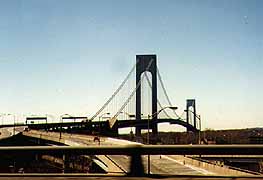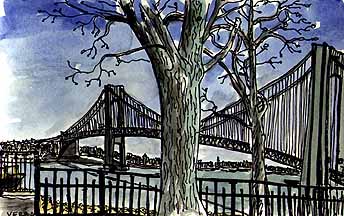American Sabbatical 65: 3/7/97
Verrazano
3/7.. Higganum.
I woke up exhausted on Thursday morning. All the turmoil of getting on the road,
the long day’s drive, and all the rich fare hit like a ton of
bricks. Even a hike through the Connecticut woods couldn’t blow
away the wearies. But the wind sure tried. The cold front behind
all that downpour was slamming the trees around, sending showers
of small limbs crashing through the woods.
There were still patches of snow in the northern niches, but the
frost was letting go of the surface litter, and sidestepping through
the roaring trees was a muddy business. I circled round, following
old stone fences through the 40-year-old thirdgrowth.. big oaks
and maples mostly.. which had reclaimed the hard won farmsteads.
The cycles of hardscrabble settlement, westering abandonment,
then commercial timber harvesting had ended in the 1950’s when
Herb bought these acres, for a song (or a painting). Now there
was no sign of those histories besides the carefully constructed
walls and the traces of logging roads.
I huffed along one until I struck Herb’s studio. He put it up
when I was a kid, and later built the house, which he and Lois
are still adding onto. I spent part of one lonely summer camped
out here while the lady I was chasing was off having romantic
experiences in Greece. Now she joined me to see Herb’s latest
work, in various stages of completion.
A double portrait of a couple which was striking for its balance.
Here was a clear depiction of two strong personalities in a marriage
of true minds. Her pursed mouth deliciously evocative in a net
of midlife wrinkles; his glasses a tour de force framing an absolutely
clear-sighted gaze. The stunning portrait of a surgeon whose clever
hands and kind eyes jumped out at you from a figure you could
reach your arms around. I had thought Herb had reached the peak
of his technical mastery decades ago, but every time I see his
work it gets stronger. No matter what you think about traditional
portraiture, you have to admire the pure skill of this contemporary
master.
Herb has done a recent painting of Jimmy Carter, in profile, staring
over his folded hands, which captures the man entirely, and his
big painting of Arthur Miller just wows me. We had seen this one
in the under-painted stage.. a monochromatic portrait in umbers..
and been blindsided by its impact. Now, with the colors washed
on, the depth produced by this technique made Miller step out
of the canvas. Inspiring stuff for a novice dauber, and a high
standard to match for a portrait carver.
We went downhill to Herb’s son Bill’s home/workshop, where he
makes reproduction furniture and dandles a grandchild, and talked
shop in the sawdust. How lucky for three generations to share
a creative life in the windy woods. Pretty good for a poor farm
boy, son of a Lithuanian immigrant in the Connecticut Valley,
who never stopped realizing his vision.
But we had a vision to pursue, too, and we poured our weary selves
into the Owl and pointed him south by east for Higganum. We had
one last stop to make in New England before galloping toward the
sun: my Uncle Bryce’s. We took the slow road across central Connecticut,
jogging right or left every half-dozen miles, avoiding the big
towns and the red highways. Even in late-winter sienna and gray
the Nutmeg State has a postcard quality. The high steepled churches
and tidy commons, the foursquare colonial houses and maple-lined
roads, all redolent of fine antiques. Which is why the antique
business does so well in this state.
Uncle Bryce has been an antique dealer since my infancy, and his
world has colonial furnishings with a high patina. He lives in
a small saltbox cape circa 1730 (the Richard Skinner House) at
the site of a now vanished grist mill, with a waterfall making
white noise in the back garden. The stooping garret bedroom we
use has portraits of George and Martha over the bed, and the whole
house has the compressed comfort of a smaller age (watch your
head). It also is full of nooks where you can curl up with a book,
or in the company of period artifacts. Unlike the houses of so
many collectors, this is a totally comfortable place where the
antiques aren’t on display, they are part of a life.
Of course the place is falling down. Ivy has devoured the clapboards,
the foundation is crumbling, you couldn’t paint for all the ingrown
plantings, and Bryce has let the flowerbeds go wild in his solitary
old age. But his hospitality is always stylish and graceful, and
his stories are outrageous. He inherited my grandfather’s gift
of the tall tale, and polished it with years as a salesman. He
tells of great antiquing coups and thieves he has known, and you
come away wondering if anything in the shops was ever authentic.
Bryce insisted we dine out at the local German restaurant, the
Glockenspiel, and there he told us a story about a local gun collector.
Apparently this man had amassed a superb collection of boobytrap
Luger pistols, designed to shoot backwards or sideways. Bryce
had assumed they were more novelties than valuables, but when
the collector died one of Bryce’s friends quietly approached him.
Did he know the widow? Yes, quite well. Did he think she might
sell the Lugers? Bryce asked her. She didn’t know, wasn’t sure
what to do, was too distraught to think about it yet. Bryce’s
dealer friend said he would pay a million dollars cash, but to
sound her out discretely when it was possible.. and at a lesser
price, perhaps. Six weeks later Bryce happened to ask the widow
if she might be interested in selling. Oh, she said, she’d sold
them to the nicest young man for $10,000. “And that young man
is 100% CROOK,” Bryce concluded.. wistfully, I thought.
The Bryces, older and younger, sat up late examining old scotch
and trading lies, which is one reason this report is falling farther
and farther behind. But we’re on an historical quest, aren’t we?
And this was a chance to get the inside line in a state whose
early reputation was for selling wooden nutmegs to colonial housewives.
Seems like they’re still at it, at least in the antique trade.
The owner of the shop where Bryce now works specializes in renovating
family portraits. He buys terrible old ancestor paintings and
repaints the faces as pigs.. or chickens.. or.. which he sells
at a handsome profit. Would you like something for over the mantle?
3/8.. Southward.
Friday morning it was time to leave the scene of the crime, and get South. The air was hovering
around freezing when we finished our morning stroll along the
river and belted into the Festiva. Only the very tip ends of Bryce’s
crocuses were poking through the lawn. Spring was just a faint
promise in Connecticut, so we would have to go find it.
By 9 AM we were scuttling along the Conn. Turnpike when suddenly
the traffic accordioned to a crawl. But there was NO traffic coming
the other way. Then some flashing lights. Then a pile-up of slammed,
crumpled, jack-knived, spun out and otherwise jumbled automotion
in the opposite lanes. (The radio reported a “30 car accident”
later in the day.) Total chaos. There must have been a glaze of
ice on that stretch of shaded pavement, and we were sure glad
the sun was on our side. How little it takes to turn the braided
car dance into a snarled tangle of pedestrians and metal junk.
Gawkers were taking memento snaps from the overpasses as rescue
crews unpried victims with the jaws of life, and traffic was stopped
dead all the way back to New Haven, folks standing between the
cars sharing smokes and making like neighbors. We didn’t stop
to chat.
We were still on familiar turf along this industrial coast. New
Haven, Stamford, Bridgeport. But this time driving the old pike
was different. For the first time in Peggy’s life this wasn’t
a pilgrimage into family anxieties. I could hear her sighing in
the passenger seat. New York will never be the same for us again.
Isn’t it amazing how places take on the colors of our emotional
attitudes? Manhattan has been a dark and depressing place for
me for 30 years, and the drive down from Maine like a descent
into Dante’s Inferno. Now I can open my eyes and see past the
inner anguish, look at the actual colors. Scanning the FM we struck
on a program of Gregorian chants, and in that elevated antiphony
we climbed over the Whitestone Bridge and made the wide sweep
across outer Queens and Brooklyn, heading for the Verazzano.
| We made a wide circuit around Manhattan mid-day Friday, and got
to view that astonishing skyline from all the eastern vantages.
Dodging broken pavement on the city’s deteriorating roadways,
we did our owlneck thing, catching glimpses of some of the world’s
great bridges on the way. |

Verrazano
|
Our last two times in New York we’d gotten a close-up eyeful of
the Queensboro Bridge, riding the gondola up to the height of
its towers from my brother’s apartment on Roosevelt Island.. ducked
under the George Washington and the parade of spans up the Harlem
River, on our way to and from guest accommodations in Riverdale..
and seen all the sights from the Tri-Borough Bridge. I had just
finished reading Engineers of Dreams by Henry Petroski, which
is an account of America’s great bridge builders, and now saw
these incredible feats of engineering with a more informed eye.
Once you start looking at the symbolic esthetics of bridges you
can’t take them for granted again, and I'm likely to weave a bit
when a steel span catches my eye. This time through the Apple
I was determined to revisit the Verrazano-Narrows Bridge, which
I hadn’t seen since the mid-sixties. When I hung out with the
crazies at Pratt Institute, we would take architectural tours
of the city: Saarinen’s TWA terminal, the CBS building (where
I worked for a while, feeling very esthetically superior), and
the Verrazano. I remembered swinging in a neighborhood park below
the Brooklyn tower of the BIG V one night, and coming away all
dizzy. But I’d pretty much ignored bridges since. Now Petoski
had me arching the flood again.
On the way to the Varrazano we crossed the Bronx-Whitestone, an
earlier (1939) suspension tour de force by Othmar Ammann, who
also designed the George Washington. Although Petroski makes it
clear that no single designer can really take the credit for a
bridge. They are engineered by teams, double-checked by peer committees,
located and financed through endless political wrangling, built
by squads of contractors, and are more truly collaborative installations
than anything a cadre of sculptors could imagine. And they ARE
sculpture, compromised by economic utility, and torqued by decades
of peer critique and the evolution of engineering design, but
still among our greatest works of art.

NY, NY
|
Petroski’s chronicle comes as close to telling industrial history
without invoking heroism as we are presently able to stand for.
His chapters ARE titled with the names of “great bridge builders”..
Eads, Cooper, Lindenthal, Ammann, Steinman.. but he’s hard-pressed
to inflate them into giants.. I mean Lindenthal? Ammann? Do you
remember who designed Galloping Gertie (the Tacoma Narrows Bridge
that self-destructed), or the Golden Gate (Joseph Strauss)? These
are stories about a profession which practices in teams. But it
often takes a single visionary with organizational genius to pull
it off, and Ammann fills that bill for the latter day bridges
of New York. |
Both the Whitestone and the GW were retrofitted after Galloping
Gertie oscillated herself to death, incidentally. The slender
arching decks, which look like feather-light spans hanging suspended
in the early photographs, were beefed up with plate girders in
a running truss on the Whitestone, and by rushing to install the
lower deck on the GW (a process I remember going on during my
Jersey childhood). And the Big V was a beefier proposition from
the start.
Skirting Flushing Meadows, where you can see the parade of airliners
setting down into La Guardia, and look down onto the parklands
filled and planted for the World’s Fair, you get a wide-angle
view of a much earlier bridge, and maybe the most evocative of
them all, Gustav Lindenthal’s Hell Gate Bridge. It’s that blood
red arch which carries westbound rail traffic into the city (a
spandrel braced arch design, the book says), and it somehow satisfies
all my cravings for a symbolic crossing over. Sigh.
After intersecting the industrial wastelands and pre-war suburbs
of the eastern boroughs, we scooted along the Belt Parkway, with
a sea of fragmitie waving in the Atlantic breeze between us and
the Rockaway beaches. Then around a bend the big bridge towers
up, and swings over. I pulled onto the shoulder and just dug it.

View from Staten Island
But not for long. The edge of a New York highway is no place to
linger, so we opted to spiral up, cross over to Staten Island,
then go hunting for a place to sketch and chow down. We found
both in a low rent neighborhood, and I shivered in the ocean wind
trying to capture the scene. Big container-ships pushing through
the narrows, freighters anchored in the stream, sea-going tugs
hotdogging past, the hedgehog city bristling on horizon. A trio
of bundled-up Middle-easterners admired my efforts in partial
English.. “ver gud. ver gud”.. while Peggy curled up in the Owl
with a pot-boiler. Another hostile encounter with the dangerous
city.
Then we struck out for Jersey and the thundering corridor of the
megalopolis. But the hard-charging commerce and the highway whine
couldn’t suppress the fact that spring was smiling on the Garden
State. Willows had been pussying out along the Connecticut shore,
but here the buds were reddening and the grass in the margins
was sprouting in pale green. I jacked up the revs, humming tropical
airs.
But the cold steel bridges weren’t about to let us forget them.
Coming up on the Delaware Watergap with its twin green arches,
the traffic was funneled into a single lane, and we inched along
in the left lane. As we crested the peak, we realized it was an
emergency response team waving us past, and there was a nondescript
guy standing on an outboard girder, looking over his shoulder
at the big drop. Below him on the roadway a roly-poly guy with
a friendly face was gesturing in the air with his hands and shrugging
at fate. Couldn’t have been New York: nobody was yelling, “Jump,
f’crissake.”
It was downhill all the way to Baltimore, straight into the setting
sun. We were aiming for Peggy’s cousin Roni’s house in Columbia,
Maryland, and the way led through crabcity rush-hour, with a sidedressing
of eyestrain. The city skyline winked in our peripheral vision
as we emerged from the harbor tunnel, and we joined the Friday
exodus to a planned paradise.
Columbia was one of those planned communities laid out in the
60’s, when everything seemed possible. The concept was for villages
of mixed income housing, with a mixed racial population (on the
outskirts of racist Baltimore), built in circular clusters with
shops and necessary services at the center. Wide streets for slow-moving
cars and pedestrians, lots of green space and strict zoning to
keep the surrounding farmland bucolic.
As with everywhere else the “rural” roads are now clogged with
Nissans and Hondas, and the mom and pop stores at the commercial
hubs are struggling to compete with franchisification. We were
early, so we drove into Harper’s Choice for a few necessities,
and found the shopping center was being eviscerated for an expansive
mall installation. As we wended our way through the serpentine
roads named after Whitman poems, past the sanitized new condos
and the older single family separates with immaculate plantings,
it was hard to see how Columbia differed from other burbs. I began
to feel a little claustrophobic.
Luckily Roni and Stan are too much fun to be stereotyped, and
we weren’t in their house five minutes before a comedy of errors
erupted, and the family laughter made this home a welcome refuge
in the middle of America.


